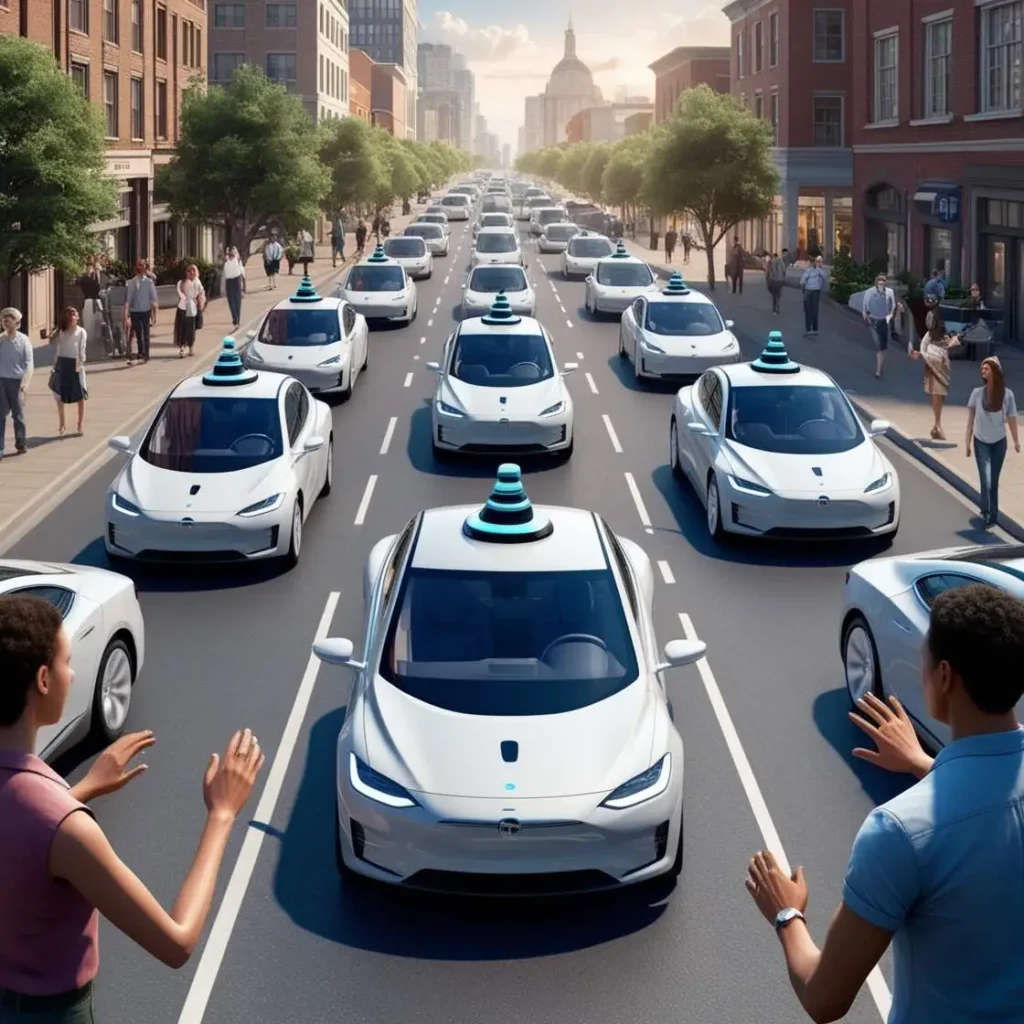The Emergence of Autonomous Vehicles
The landscape of the automotive industry is undergoing a remarkable transformation with the emergence of autonomous vehicles. These vehicles, capable of operating without human intervention, promise to revolutionize the way we think about transportation. As technology advances and public interest grows, the potential impact of autonomous cars on society, the economy, and the environment becomes increasingly significant. In this article, we will explore the evolution of autonomous vehicles, their benefits and challenges, the role of regulations, and the future they may hold.
The journey of autonomous cars began several decades ago. Initially, the concept was largely relegated to the realm of science fiction. However, with advancements in technology, including artificial intelligence, machine learning, and sensor technology, the dream of self-driving cars is becoming a reality. According to a 2021 report by McKinsey, the global market for autonomous vehicles is projected to reach $1.3 trillion by 2030, highlighting the immense potential of this technology.

Index
Understanding Autonomous Vehicles
At its core, the term “autonomous cars” refers to vehicles equipped with technology that allows them to navigate and drive without human input. These vehicles utilize a combination of sensors, cameras, radar, and artificial intelligence algorithms to perceive their surroundings and make driving decisions. The Society of Automotive Engineers (SAE) has established a classification system for autonomous vehicles, which ranges from Level 0 (no automation) to Level 5 (full automation).
Most autonomous cars currently in development are classified at Levels 2 and 3, where the vehicle can handle specific driving tasks but requires human oversight. Level 2 vehicles can control acceleration and steering but still require the driver to pay attention and be ready to take over. Level 3 vehicles can manage most driving tasks but might need a human driver to intervene under certain circumstances, such as poor weather conditions.
However, Level 4 vehicles can operate independently in specific conditions, such as urban environments or designated areas, while Level 5 vehicles can handle any driving scenario without human intervention. This level represents the ultimate goal for many companies in the automotive industry. The transition between these levels will shape the future of transportation as we know it.
The Benefits of Autonomous Vehicles
The emergence of autonomous cars carries numerous potential benefits, making them an attractive option for both consumers and policymakers.
Safety Improvements
One of the primary advantages of autonomous cars is the potential for enhanced safety on the roads. According to the National Highway Traffic Safety Administration (NHTSA), over 94% of car accidents are caused by human error. By eliminating the human factor, autonomous vehicles could significantly reduce the number of accidents, injuries, and fatalities. A study conducted by the Insurance Institute for Highway Safety (IIHS) found that if autonomous vehicles were adopted widely, they could prevent up to 90% of crashes.
The technology behind autonomous cars is designed to react faster than human drivers. Sensors and cameras allow these vehicles to perceive their surroundings in real-time, identifying potential hazards well before a human driver would. This ability to monitor multiple inputs simultaneously means that autonomous cars can make decisions based on a broader range of information, leading to safer driving outcomes.
Traffic Efficiency
Autonomous cars have the potential to improve traffic flow and reduce congestion. These vehicles can communicate with each other and infrastructure, enabling optimized routing and reduced travel times. A report by the Texas A&M Transportation Institute suggests that widespread adoption of autonomous vehicles could lead to a 30% decrease in traffic congestion in urban areas.
The way autonomous cars communicate with one another can also help prevent traffic jams. For instance, if one vehicle detects that a road is congested, it can relay that information to others, prompting them to take alternate routes. This collective intelligence can lead to a more fluid and efficient transportation network.
Additionally, autonomous vehicles can maintain optimal speeds and distances between themselves, preventing sudden stops and starts that contribute to traffic slowdowns. By smoothing out the flow of traffic, these cars can reduce the overall time spent on the road, benefiting both individuals and the economy.
Environmental Impact
The shift toward autonomous cars could also have a positive environmental impact. With the integration of electric vehicles into the autonomous car landscape, there is the potential for reduced emissions. According to a study by the Massachusetts Institute of Technology (MIT), autonomous electric vehicles could reduce greenhouse gas emissions by up to 80% compared to traditional gasoline-powered cars.
Electric autonomous cars not only eliminate tailpipe emissions but can also contribute to cleaner urban air. In addition to reducing carbon dioxide emissions, the reduction of other harmful pollutants, such as nitrogen oxides and particulate matter, can significantly improve air quality in cities.
Furthermore, autonomous vehicles often use more energy-efficient driving patterns. For example, they can optimize their speed to minimize energy consumption and take advantage of regenerative braking systems, which recover energy during braking. This enhanced efficiency can lead to reduced energy use and lower operational costs.
Challenges and Concerns About Autonomous Vehicles
Despite the potential benefits, the emergence of autonomous cars presents various challenges and concerns that must be addressed.
Technological Limitations
While advancements in technology have been significant, there are still challenges to overcome before autonomous cars can operate safely and efficiently in all conditions. Weather conditions, such as heavy rain, fog, or snow, can hinder sensor performance, making it difficult for the vehicle to perceive its surroundings accurately. For instance, lidar, a common sensor used in autonomous vehicles, can struggle to function in heavy precipitation.
Moreover, complex urban environments with unpredictable human behavior present another challenge for autonomous vehicles. Scenarios like pedestrians unexpectedly crossing the street or cyclists weaving through traffic can pose risks that are difficult for current algorithms to handle. As they continue to evolve, ongoing research and development are necessary to address these limitations.
Regulatory Hurdles
The regulatory landscape surrounding autonomous cars is still developing. Governments around the world must create comprehensive regulations to ensure the safe integration of autonomous vehicles into existing transportation systems. This includes establishing safety standards, liability frameworks, and guidelines for testing and deploying autonomous technology.
In the United States, the NHTSA has released guidelines for the testing and deployment of autonomous vehicles, but there is still a lack of uniformity across states. This fragmented regulatory environment could hinder the widespread adoption of autonomous cars. Different states may have varying laws regarding testing, insurance requirements, and liability in the event of an accident, leading to confusion and potential legal complications.
Internationally, countries are at different stages of regulatory development. For instance, while countries like the Netherlands and Singapore are pushing forward with favorable regulations for testing autonomous vehicles, others may lag behind, creating disparities that affect cross-border operations.
Public Acceptance
Public perception and acceptance of autonomous cars will play a crucial role in their success. Many people remain skeptical about the safety and reliability of self-driving vehicles. A survey conducted by the Pew Research Center found that 57% of Americans believe autonomous vehicles will make roads less safe. Education and outreach efforts will be essential to inform the public about the benefits and safety of autonomous technology.
Consumer trust is vital for the adoption of autonomous vehicles. Manufacturers and technology companies must demonstrate that their systems are not only reliable but also secure from hacking and other cyber threats. Building a robust public relations strategy that addresses concerns and showcases the safety features of autonomous cars will be necessary to alleviate fears.
Furthermore, cultural differences may affect the acceptance of autonomous vehicles in different regions. For example, societies that prioritize personal freedom and control may resist the idea of relinquishing control to a machine, while others may embrace the technology for its convenience and safety benefits.
The Future of Autonomous Cars
As we look to the future, the emergence of autonomous cars is poised to reshape transportation in profound ways. Several trends indicate a promising outlook for self-driving vehicles.
Collaboration Between Automakers and Tech Companies
The development of autonomous cars is no longer confined to traditional automakers. Tech companies such as Google (Waymo), Tesla, and Uber are investing heavily in autonomous vehicle technology. Collaborations between automakers and tech firms will accelerate innovation and development, leading to more advanced and safer autonomous vehicles.
Partnerships between tech companies and traditional automotive manufacturers allow for the sharing of resources, expertise, and technology. This collaborative approach can lead to more effective and quicker advancements in autonomous driving technology. For instance, Tesla’s success in the electric vehicle market has been enhanced by its focus on software development, enabling over-the-air updates and improvements to its autonomous driving features.
Smart Infrastructure Development
The integration of autonomous cars into transportation systems will require the development of smart infrastructure. This includes connected traffic signals, smart roads, and communication networks that enable vehicles to interact with their environment. Investments in smart infrastructure will facilitate the safe and efficient operation of autonomous vehicles.
For example, smart traffic signals that can communicate with autonomous vehicles can optimize traffic flow and reduce wait times at intersections. Furthermore, smart parking solutions can direct autonomous cars to available spaces, reducing the time spent searching for parking and decreasing congestion.
The development of vehicle-to-everything (V2X) communication technologies will be critical. This technology allows vehicles to communicate not only with each other but also with infrastructure, pedestrians, and even cyclists. By sharing real-time information, V2X can significantly enhance safety and efficiency on the roads.
Increased Adoption of Mobility-as-a-Service (MaaS)
The rise of autonomous cars is likely to spur the growth of Mobility-as-a-Service (MaaS) platforms. These services integrate various transportation options, such as ride-hailing, public transit, and autonomous vehicles, into a single user-friendly platform. MaaS can provide greater convenience and flexibility for users, ultimately leading to increased adoption of autonomous cars.
The concept of MaaS represents a shift away from personal vehicle ownership towards a more sustainable and efficient model of transportation. By offering users a range of transportation options through a single app, MaaS can cater to diverse needs and preferences, making it easier for individuals to choose public transport or shared rides instead of personal cars.
Conclusion
The emergence of autonomous cars represents a significant milestone in the evolution of transportation. With the potential to enhance safety, improve traffic efficiency, and reduce environmental impact, autonomous vehicles hold great promise for the future. However, challenges remain in terms of technological limitations, regulatory hurdles, and public acceptance.
As automakers, tech companies, and governments work together to address these challenges, the path toward widespread adoption of autonomous cars will become clearer. With continued investment, innovation, and collaboration, we may soon find ourselves living in a world where self-driving vehicles are an integral part of our daily lives, transforming the way we travel and shaping the future of transportation.
